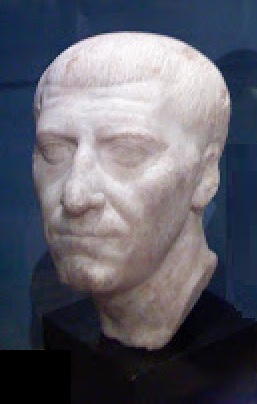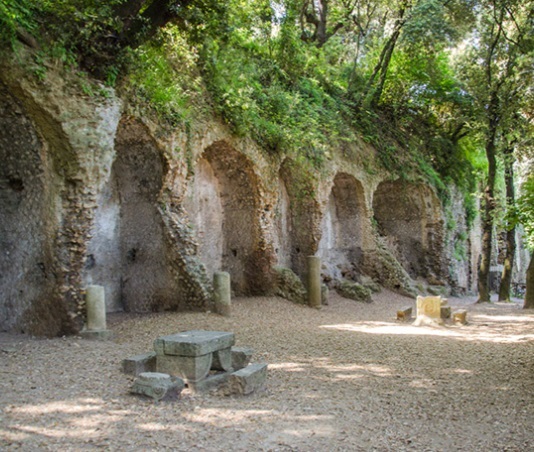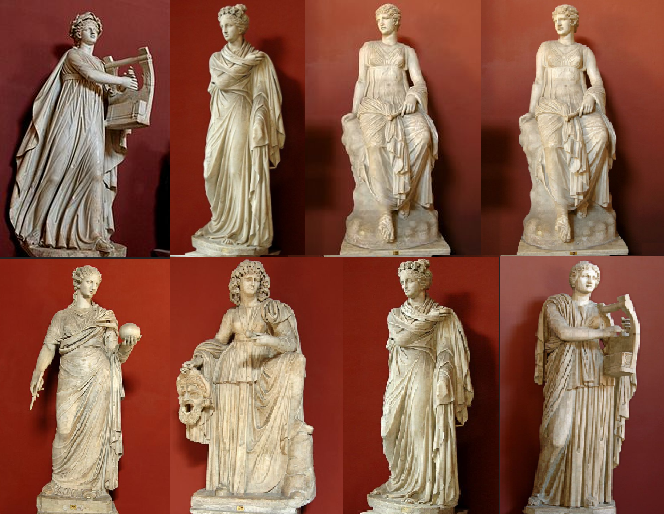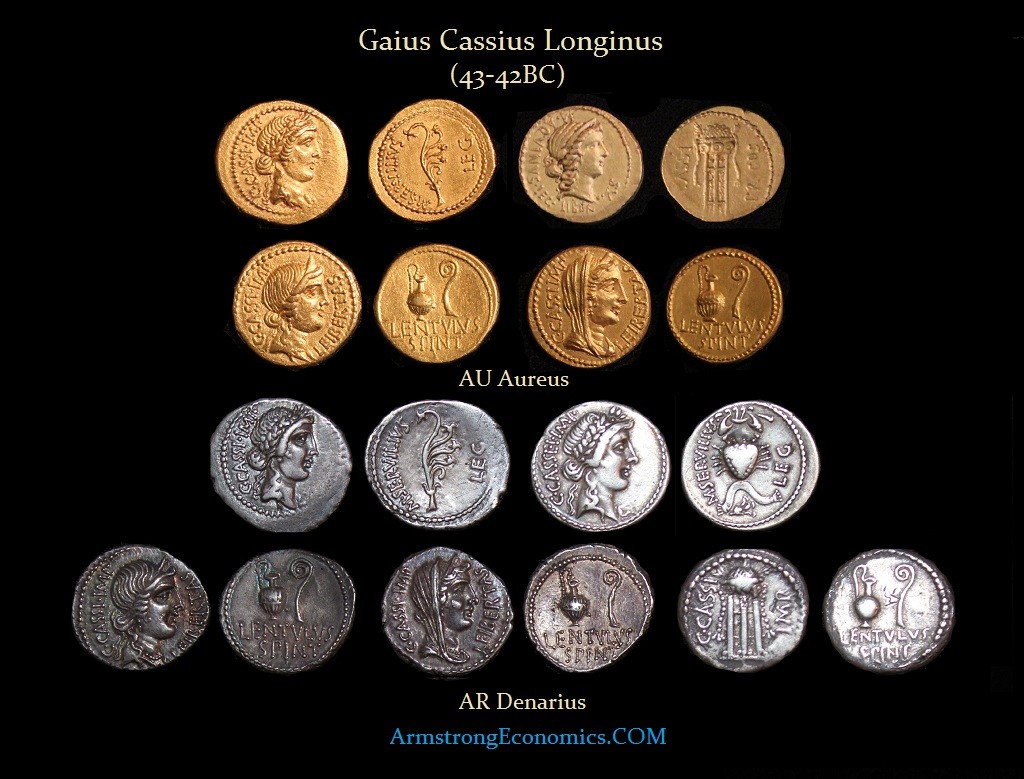Gaius Cassius Longinus
Imperator, 44 – 42 BC
Assassin of Caesar
died 42 BC
Gaius CASSIUS Longinus was appointed Quaestor in 53 BC. Little is known of his early life. Much of what has come down is related to the period of the Civil War. Cassius had served in the military under Marcus Crassus – a member of the 1st Triumvirate. At the battle of Carrhae against the Parthians, he stood by and watched the annihilation of the famous Crassus. It is at that point in his career that power seemed to come his way. In the aftermath of the battle, Cassius assumed control of the meager remnants of the legions, returning in 52 BC to eventually defeat the Parthians. Cassius had formed a power base in Syria that allowed him to extort money from anyone who wished to trade in the area. As such, this position enabled him to increase his wealth significantly.

Cassius was appointed Tribune in 49 BC. Despite serving under Crassus, a member of the 1st Triumvirate with Caesar, Cassius sided with Pompey and the corrupt Senate of Rome against Caesar. Gaius Cassius Longinus rose to prominence by his reputation, justly deserved, as a very able military commander. As questor to Marcus Crassus, he successfully saved what was left of the legions after the disaster at Carrhae in 53 A.D., and two years later fended off a Parthian invasion by Pakorus. Pardoned by Caesar for his service as tribune for the Pompeian side in the Civil War, he was appointed legate and later praetor peregrinus of Rome. As such he was the second-highest-ranking official in the city. The highest office, praetor urbanus was awarded to another protégé of Caesar, Marcus Junius Brutus. Unwittingly Caesar had empowered the seeds of his own demise. Indeed, it appears that Cassius was the progenitor of the conspiracy to kill Caesar.
Despite the fact that Cassius was then later pardoned by the naive Caesar and made a Legate in 48 BC, Cassius remained a greedy man intent upon following his own self-interest – the pursuit of wealth. After Caesar’s pardon in 48 BC, Cassius became politically active in “Republican Causes” and aligned himself with the wealthy corrupt nobles and senators of Rome. In 44 BC, Cassius became a Praetor, and it was proposed that he be given the governorship of the Syrian provinces the following year. Earlier, as a supporter of Pompey, Cassius had been an associate of Brutus as well and in fact was married to Brutus’ half-sister, Junia Tertulla. This association grew as both men appeared to have the same goal – to be part of the great mercantile monopoly that virtually controlled the Senatorial appointments. As such Cassius was in the middle of senatorial corruption for his personal expansion of wealth. Cassius was bound by marriage and the winds of fortune to Brutus for he married Brutus’ sister Tertulla.
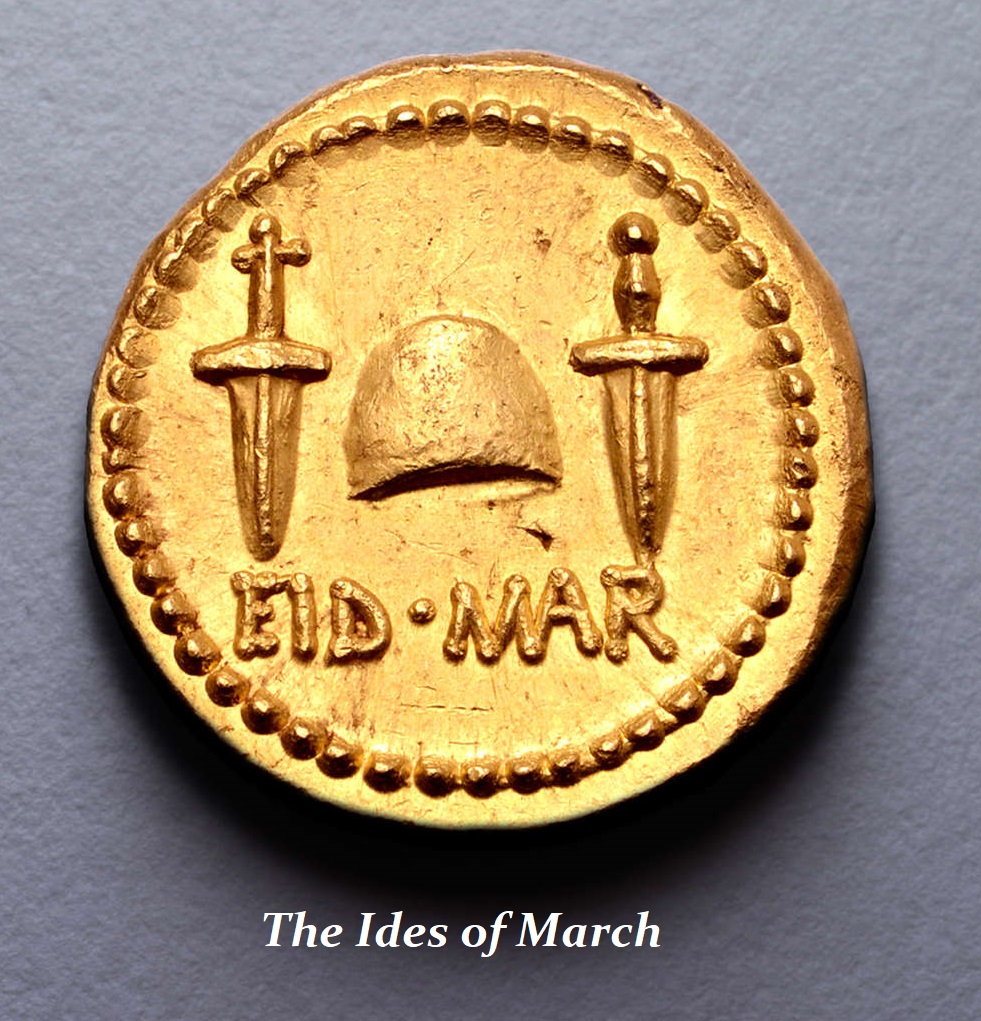 When Caesar moved to end the corrupt appointment system, Cassius and Brutus conspired with the noblemen to assassinate Caesar in the Senate chamber on the Ides of March (15th), 44 BC. In the aftermath of the public outcry, orchestrated by Marc Antony, Cassius was forced to flee Rome. He at first fled to Sicily where he was given the commission to export corn to Italy. In September of that year, he fled to Syria, his old home territory. Cassius retained many associations in Syria where he ousted Dolabella, one of Marc Antony’s Counselors, and assembled an army.
When Caesar moved to end the corrupt appointment system, Cassius and Brutus conspired with the noblemen to assassinate Caesar in the Senate chamber on the Ides of March (15th), 44 BC. In the aftermath of the public outcry, orchestrated by Marc Antony, Cassius was forced to flee Rome. He at first fled to Sicily where he was given the commission to export corn to Italy. In September of that year, he fled to Syria, his old home territory. Cassius retained many associations in Syria where he ousted Dolabella, one of Marc Antony’s Counselors, and assembled an army.
Plutarch held Cassius in low regard, describing him as a man who was not well-liked and who ruled his soldiers through fear. He wrote:
“…Cassius was known to be a man of violent and uncontrolled passions, whose craving for money had often tempted him to stray from the path of justice, and it, therefore, seemed natural that his motive for fighting, wandering about the empire and risking his life was not to win liberty for his fellow-countrymen but to secure some great place for himself.”
Plutarch has precisely the opposite to say of Cassius’ co-conspirator: “Brutus’ virtues, on the other hand, made him popular with the rank and file, beloved by his friends, and admired by the nobility, while even his enemies found it impossible to hate him.” With this in mind, one can imagine the simmering conflict between the two leaders, with Cassius being increasingly resentful of Brutus’ popularity; indeed, their rivalry was no less significant than that of their opponents, Marc Antony and Octavian.
By the time they met at Sardis and were hailed imperator by their troops, the strains of partnership had reached an intolerable pitch. Plutarch states:
“…as often happens in great enterprises in which a large number of friends and commanders are engaged, there had been some sharp differences and mutual accusations had been exchanged. So…their first action was to meet in a room face to face. The doors were shut, and with no one else present the two men first began blaming one another and then fell to recriminations and counter-charges. These soon led to indignant reproaches and tears, and their friends, who were amazed at the vehemence and bitterness of their anger, were afraid that the quarrel might end in violence.”
This confrontation occurred just before Brutus departed to campaign in Lycia and Cassius set out to capture Rhodes, which he did successfully, but with extreme severity.

This aureus was struck after Cassius’ defeat of the Rhodians, for the reverse depicts an aplustre, a ship ornament that symbolized naval victory. It was struck by Marcus Servilivs Legatus and the flowers at the extremities of the ornament suggest Rhodes since the rose had been the symbol of that island for many centuries. Its symbolism is sealed when the other issue of this legate is considered: it shows a crab holding an aplustre in its claws, above a loose diadem and a rose. This rose is a certain reference to Rhodes, and it appears below the crab, the badge of the island of Cos, near where the decisive battle took place. The loosened diadem might symbolize the kingship Cassius claimed to have undone at Rhodes (Plutarch, Brutus, 30) or it could be a general reference to the termination of Julius Caesar’s tyranny some two years before.
In the summer of 42 BC, Cassius joined forces with those his co-conspirator – Brutus. They planned to confront the combined legions of Antony and Octavian at Philippi. The battle was lost and Cassius, having a little alternative, committed suicide by ordering his shield bearer to put him to death as quickly as possible. Cassius never used his portrait on the coinage he issued preferring instead to display the image of Liberty either veiled or bareheaded as a means of propaganda.
Another Gaius Cassius Longinus of the mid-1st century AD was a descendant of the famed Cassius of the same name. Later Cassius was a lawyer or jurist and served as a governor during the reigns of Caligula and Nero. He served as governor of Syria in 45 AD, or perhaps earlier, and authored 10 books on civil and other forms of law. In 58 AD, he criticized Nero for having too many honors, and in 65 AD was charged with revering too greatly the memory of his ancestor Cassius. He was eventually banished by Nero to Sardinia. He returned to Rome once again under Vespasian and lived out his days in great popularity. He reportedly went blind at the end of his life.
Cassius had a villa not too far from Hadrian’s Villa. It was excavated in 1774 by Pope Gregory XVI ( 1765 – 1846) to make a park known as the Villa Gregoriana in Tivoli
Apollo is shown crowned with laurel and wearing the long, flowing robe of the Ionic bard. The statue was found in 1774, with seven statues of the Muses, in the ruins of Gaius Cassius Longinus’ villa near Tivoli, Italy. The sculptures are preserved in the Hall of the Muses, in the Museo Pio-Clementino of the Vatican Museums.
Monetary System
Mints: Military moving mint
Obverse Legends
DENOMINATIONS
AU Aureus (8.18 grams)
AR Denarius (4.16-3.80 grams)
Note: Silver content 96%
Monetary History of the World
© Martin A. Armstrong

